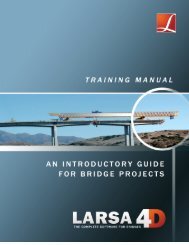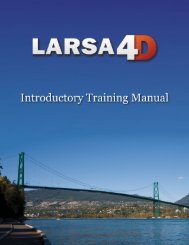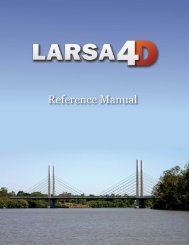Create successful ePaper yourself
Turn your PDF publications into a flip-book with our unique Google optimized e-Paper software.
(continued from page 7)<br />
impossible due to other structural elements in the model, and<br />
in this case the procedure could be left to adjust pretension<br />
values indefinitely. The cable pretension values for the nine<br />
cables in a typical model after each iteration are shown in<br />
Figure 2. At the first iteration the cables are all set to a common<br />
initial prestress force.<br />
Iteration Using Unit Loading and a Flexibility Matrix<br />
In a segmental assembly a cable may be installed after its<br />
segment has already deformed due to dead load. The goal<br />
here is to achieve zero joint displacement, but because the<br />
cable is installed in the middle of the construction sequence<br />
the cable is intended to deform as it brings the joint back up to<br />
its initial location. Since the cable will deform, the initial cable<br />
tension will not match final cable tension, the first procedure is<br />
not applicable in this case.<br />
A different method is required in this case. The “unit load<br />
method” has been applied in the past to solve this problem. In<br />
this method, we apply a unit-tug — i.e. one extra unit of jacking<br />
force — to each cable and observe its effect on each of the<br />
joints at the bases of the cables (or any other joints on the<br />
deck). Then we solve for a factor to apply to the tug to zero-out<br />
the displacements at a joint. Take the case of a single cable.<br />
At the initial condition, the joint at the base of the cable has<br />
displaced by 5 meters. Through a static analysis we determine<br />
that adding 1 kN of force to the cable raises the joint by 1<br />
meter. We then conclude that 5 times the 1 kN = 5 kN will raise<br />
the joint back to its undeformed location. If the structure has<br />
nonlinear behavior 5 kN may not have the effect of 5 times<br />
the effect of 1 kN, so the process must be iterated until the<br />
displacement comes within tolerable limits.<br />
Figure 2. Cable pretension values for nine cables after the<br />
first 35 iterations.<br />
This is the application of a procedure used in many other fields<br />
of applied mathematics and is a generalization into multiple<br />
dimensions of the Newton-Raphson method of finding the<br />
solution to f(x) = 0. As opposed to the first iterative method<br />
described above, f(x) here is a function from a vector of cable<br />
pretension forces to a vector of joint deformations in the<br />
elevation axis.<br />
The Newton-Raphson method can be summarized as follows:<br />
when searching values of x for the one that makes f(x) = 0, a<br />
•LARSA’s 4D <strong>Journal</strong>•October 2009•Page 8<br />
good guess is to use the slope of f to predict where the function<br />
is going. This is shown in Figure 3, and formally in Equations<br />
1–2, where f´ denotes the derivative of f.<br />
eqn 1. f´(x) . ∆x = -f(x)<br />
eqn 2. ∆x = f(x)<br />
f´(x)<br />
When there is more than one cable this process must be<br />
generalized to multiple dimensions, and the iterative step is<br />
derived as shown in Equations 3–4. The matrix J, called the<br />
Jacobian matrix, represents the slope of the function in each<br />
dimension. J ij is the change in displacement at joint i due to<br />
a one-unit tug on cable j. ∆x is the computed additional initial<br />
cable tension that is needed and is added in at the end of the<br />
current iteration.<br />
eqn 3. J . ∆x = -f(x)<br />
eqn 4. ∆x = -J -1 f(x)<br />
J is computed by running a separate static analysis for each<br />
column of the matrix. Each analysis applies a one-unit tug<br />
u i to each cable at the time it is installed, within a Staged<br />
Construction Analysis already set up by the user that might<br />
additionally contain dead load, time-dependent material<br />
effects, and other nonlinear behavior. For each analysis we<br />
record the displacement of the joints at the bases of the cables<br />
at the end of construction (i.e. at the final construction step)<br />
and subtract off the corresponding displacements without the<br />
unit tug.<br />
-f(x)<br />
first iteration<br />
x x′<br />
∆ x<br />
second iteration<br />
solution<br />
Figure 3. Illustration of Newton-Raphson<br />
in one dimension.<br />
The cable jacking forces can be applied at different times, i.e.<br />
at different stages during a construction analysis that takes<br />
into account time-dependent material properties, temporary<br />
loading, other construction activities, and geometric<br />
nonlinearity. The algorithm will find whatever pretension force<br />
such that the deformations work out at the end.<br />
More details on using these tools can be found in the<br />
documentation section of our website http://www.larsa4d.<br />
com.•<br />
f







